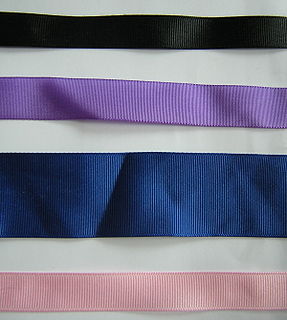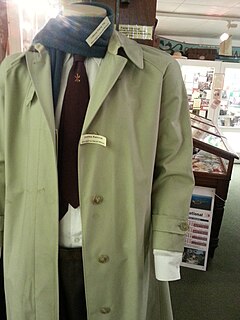Related Research Articles

Ohm's law states that the current through a conductor between two points is directly proportional to the voltage across the two points. Introducing the constant of proportionality, the resistance, one arrives at the usual mathematical equation that describes this relationship:

A textile is a flexible material made by creating an interlocking network of yarns or threads, which are produced by spinning raw fibres into long and twisted lengths. Textiles are then formed by weaving, knitting, crocheting, knotting, tatting, felting, bonding, or braiding these yarns together.
Cellophane is a thin, transparent sheet made of regenerated cellulose. Its low permeability to air, oils, greases, bacteria, and water makes it useful for food packaging. Cellophane is highly permeable to water vapour, but may be coated with nitrocellulose lacquer to prevent this.

Suede is a type of leather with a sueded finish, commonly used for jackets, shoes, fabrics, purses, furniture, and other items. The term comes from the French gants de Suède, which literally means "gloves from Sweden".

A ghillie suit is a type of camouflage clothing designed to resemble the background environment such as foliage, snow or sand. Typically, it is a net or cloth garment covered in loose strips of burlap (hessian), cloth, or twine, sometimes made to look like leaves and twigs, and optionally augmented with scraps of foliage from the area.

Tie-dye is a modern term invented in the mid-1960s in the United States for a set of ancient resist-dyeing techniques, and for the products of these processes. The process of tie-dye typically consists of folding, twisting, pleating, or crumpling fabric or a garment and binding with string or rubber bands, followed by application of dye(s). The manipulations of the fabric prior to the application of dye are called resists, as they partially or completely prevent the applied dye from coloring the fabric. More sophisticated tie-dyes involve additional steps, including an initial application of dye prior to the resist, multiple sequential dye and resist steps, and the use of other types of resists and discharge.
Calendering of textiles is a finishing process used to smooth, coat, or thin a material. With textiles, fabric is passed between calender rollers at high temperatures and pressures. Calendering is used on fabrics such as moire to produce its watered effect and also on cambric and some types of sateens.

Dyeing is the application of dyes or pigments on textile materials such as fibers, yarns, and fabrics with the goal of achieving color with desired color fastness. Dyeing is normally done in a special solution containing dyes and particular chemical material. Dye molecules are fixed to the fiber by absorption, diffusion, or bonding with temperature and time being key controlling factors. The bond between dye molecule and fiber may be strong or weak, depending on the dye used. Dyeing and printing are different applications; in printing, color is applied to a localized area with desired patterns. In dyeing, it is applied to the entire textile.

Sun printing may refer to various printing techniques which use sunlight as a developing or fixative agent.

Vocaloid is a singing voice synthesizer software product. Its signal processing part was developed through a joint research project led by Kenmochi Hideki at the Pompeu Fabra University in Barcelona, Spain, in 2000 and was not originally intended to be a full commercial project. Backed by the Yamaha Corporation, it developed the software into the commercial product "Vocaloid" that was released in 2004.

Waterproofing is the process of making an object or structure waterproof or water-resistant so that it remains relatively unaffected by water or resisting the ingress of water under specified conditions. Such items may be used in wet environments or underwater to specified depths.

Textile manufacturing is a major industry. It is largely based on the conversion of fibre into yarn, then yarn into fabric. These are then dyed or printed, fabricated into cloth which is then converted into useful goods such as clothing, household items, upholstery and various industrial products.

Textile printing is the process of applying color to fabric in definite patterns or designs. In properly printed fabrics the colour is bonded with the fibre, so as to resist washing and friction. Textile printing is related to dyeing but in dyeing properly the whole fabric is uniformly covered with one colour, whereas in printing one or more colours are applied to it in certain parts only, and in sharply defined patterns.

Textile geometry is the creative and technical process by which thread or yarn fibers are woven together or interlaced to form a flexible, functional, and decorative cloth or fabric which is subsequently printed upon or otherwise adorned. Textile design is further broken down into three major disciplines, printed textile design, woven textile design, and mixed media textile design, each of which utilize different methods to produce a surface ornamented fabric for variable uses and markets. Textile Design as a practice has evolved to become an industry integral to other disciplines such as fashion, interior design, and fine arts.

The Thin Man is a fictional superhero appearing in American comic books published by Marvel Comics. The character was created by artist Klaus Nordling and an unknown writer in Mystic Comics #4, and published by Marvel predecessor Timely Comics during the time fans and historians call the Golden Age of Comic Books. The Thin Man was one of the first "stretching" superheroes, predating the more famous Plastic Man by more than a year and Mister Fantastic by more than twenty years.

Grosgrain, is a type of fabric or ribbon defined by the fact that its weft is heavier than its warp, creating prominent transverse ribs. It is called a "corded" fabric since the weft resembles a fine cord. Grosgrain is a plain weave corded fabric, with heavier cords than in poplin but lighter than in faille. Grosgrain has a very dull appearance with little luster but is very strong. It is a firm, close-woven, fine-corded fabric. Grosgrain fabric is most commonly available in black, but grosgrain ribbon comes in a large variety of colors and patterns. The ribbon is very similar to Petersham ribbon in its appearance, but it does not have the ability to follow the curves of a surface or edge the way that the latter does.
The pore space of soil contains the liquid and gas phases of soil, i.e., everything but the solid phase that contains mainly minerals of varying sizes as well as organic compounds.

In textile manufacturing, finishing refers to the processes that convert the woven or knitted cloth into a usable material and more specifically to any process performed after dyeing the yarn or fabric to improve the look, performance, or "hand" (feel) of the finish textile or clothing. The precise meaning depends on context.
Wrinkle-resistant or permanent press fabrics are textiles that have been treated to resist external stress and hold their shape. Clothing made from this fabric does not need to be ironed and may be sold as non-iron, no-iron, wash and wear, durable press, and easy care. While fabric cleaning and maintenance may be simplified, some wearers experience decreased comfort.

Performance, also known as fitness for purpose, refers to a textile's capacity to withstand various conditions, environments, and hazards, qualifying it for particular end-use. The performance of textile products influences their appearance, comfort, durability, and protection. Different areas of textile applications require a different set of performance parameters. As a result, the specifications determine the level of performance of a textile product. Textile testing certifies the product's conformity to buying specification. It describes product manufactured for non-aesthetic purposes, where fitness for purpose is the primary criterion. Engineering of high performance fabrics presents a unique set of challenges.
References
- ↑ Debbie Wiener (2008), Slob Proof!: Real-Life Design Solutions, Alpha Books, p. 52, ISBN 978-1-59257-769-9
- ↑ Karla J. Nielson (10 July 2007), Interior Textiles: Fabrics, Application, and Historic Style, John Wiley & Sons, p. 108, ISBN 978-0-471-60640-6